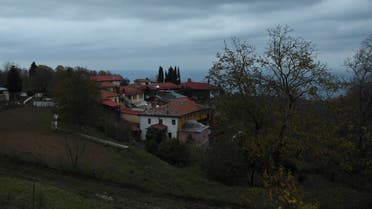
A view of the Marouda Cell at the all-male Orthodox monastic community of Mount Athos, Greece, November 17, 2021. Picture taken November 17, 2021. (File photo: Reuters)
The Associated Press
Published: 21 October ,2022:
A church bell sounds, the staccato thudding of mallet on plank summons monks to afternoon prayers, deep voices are raised in communal chant.
And high in the great tower of Pantokrator Monastery, a metal library door swings open.
There, deep inside the medieval fortified monastery in the Mount Athos monastic community, researchers are for the first time tapping a virtually unknown treasure — thousands of Ottoman-era manuscripts that include the oldest of their kind in the world.
The libraries of the self-governed community, established more than 1,000 years ago on northern Greece’s Athos peninsula, are a repository of rare, centuries-old works in several languages including Greek, Russian and Romanian.
Many have been extensively studied, but not the Ottoman Turkish documents, products of an occupying bureaucracy that ruled northern Greece from the late 14th century — well before the Byzantine capital, Constantinople, fell to the Ottomans in 1453 — until the early 20th when the area became Greek again.
Byzantine scholar Yiannis Niehoff-Panagiotidis says it’s impossible to understand Mount Athos’ economy and society under Ottoman rule without consulting these documents, which regulated the monks’ dealings with secular authorities.
Niehoff-Panagiotidis, a professor at the Free University of Berlin, said the oldest of the roughly 25,000 Ottoman works found in the monastic libraries dates to 1374, or 1371.
That’s older than any known in the world, he said, adding that in Istanbul, as the Ottomans renamed Constantinople when they made the city their own capital, the oldest archives only go back to 1480 or 1490.
Father Theophilos, a monk who is helping with the research, carefully takes out some of the more rare documents that are stored in large wooden drawers in the library of the Pantokrator Monastery, one of 20 on the heavily wooded peninsula.
These include ornate Sultans’ firmans — or decrees — deeds of ownership and court decisions.
Anastasios Nikopoulos, a jurist and scientific collaborator of the Free University of Berlin, who has been working with Niehoff-Panagiotidis on the project for the past few months said the overwhelming majority are legal documents.
And the manuscripts tell a story at odds with the traditional understanding in Greece of Ottoman depredations in the newly-conquered areas, through the confiscation of the Mount Athos monasteries’ rich real estate holdings.
Instead, the new rulers took the community under their wing, preserved its autonomy and protected it from external interference.
“The Sultans’ firmans we saw in the tower...and the Ottoman state’s court decisions show that the monks’ small democracy was able to gain the respect of all conquering powers,” Nikopoulos said.
“And that is because Mount Athos was seen as a cradle of peace, culture...where peoples and civilizations coexisted peacefully.”
Nikopoulos said that one of the first actions of Murad II, the Ottoman ruler who conquered Thessaloniki — the closest city to Mount Athos — was to draw up a legal document in 1430 protecting the community.
“This says a lot. The Ottoman sultan himself ensured that the administrative system of Mount Athos was preserved and safeguarded,” he said.
Even before that, Niehoff-Panagiotidis added, a sultan issued a mandate laying down strict punishment for intruders after a band of marauding soldiers engaged in minor thieving from one of the monasteries.
“It’s strange that the sultans kept Mount Athos, the last remnant of Byzantium, semi-independent and didn’t touch it,” he said.
“They didn’t even keep troops here. At the very most they would have a local representative who probably stayed at (the community’s administrative center) Karyes and sipped tea.”
Another unexpected revelation, Niehoff-Panagiotidis said, was that for roughly the first two centuries of Ottoman rule no effort was made to impose Islamic law on Mount Athos or nearby parts of northern Greece.
“What is strange is that the sultans kept Mount Athos as the last remnant of Byzantium,” he said.
The community was first granted self-governance through a decree by Byzantine Emperor Basil II, in 883 AD.
Throughout its history, women have been forbidden from entering, a ban that still stands.
This rule is called “avaton” and the researchers believe that it concerns every form of disturbance that could affect Mount Athos.
No comments:
Post a Comment